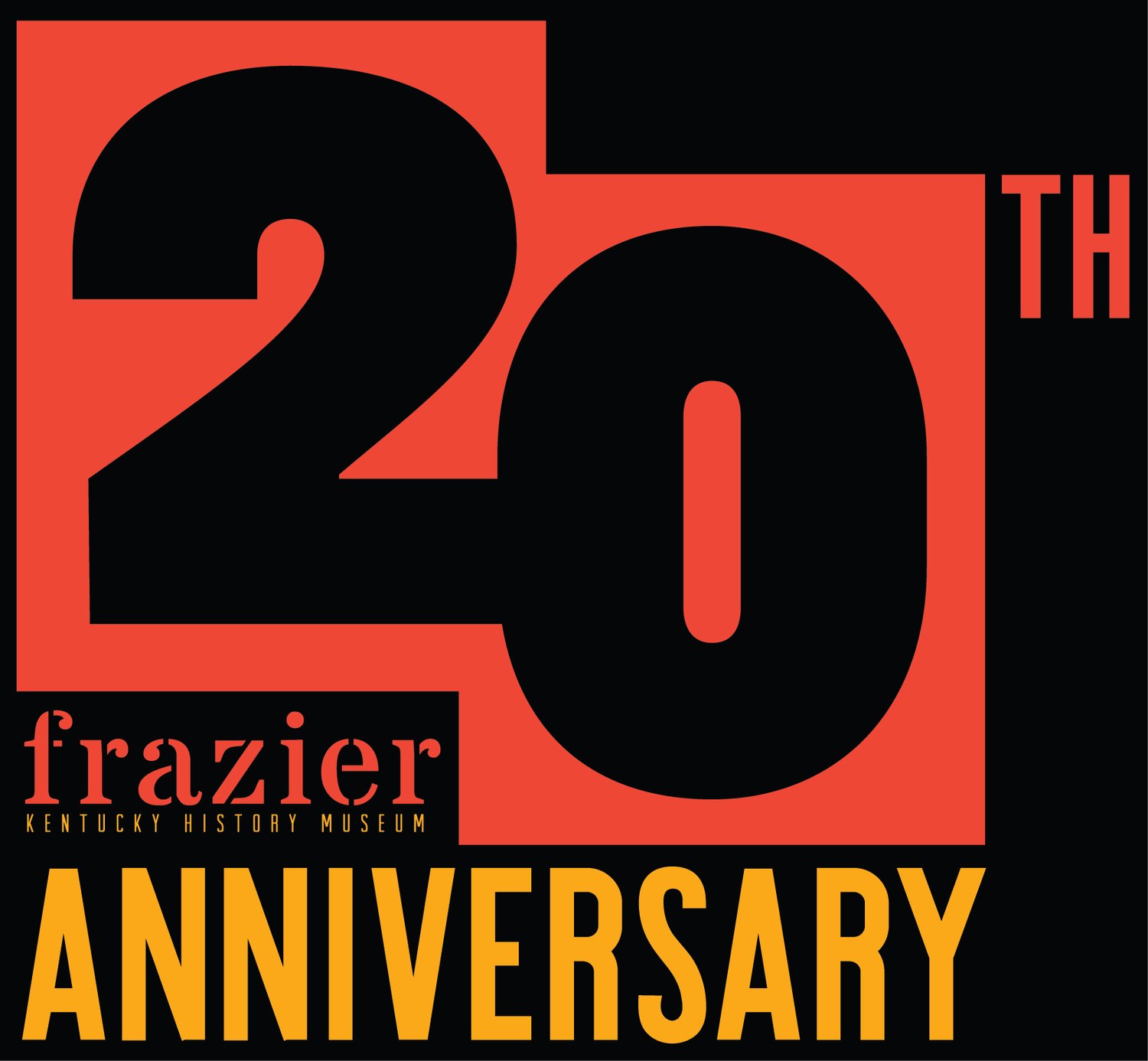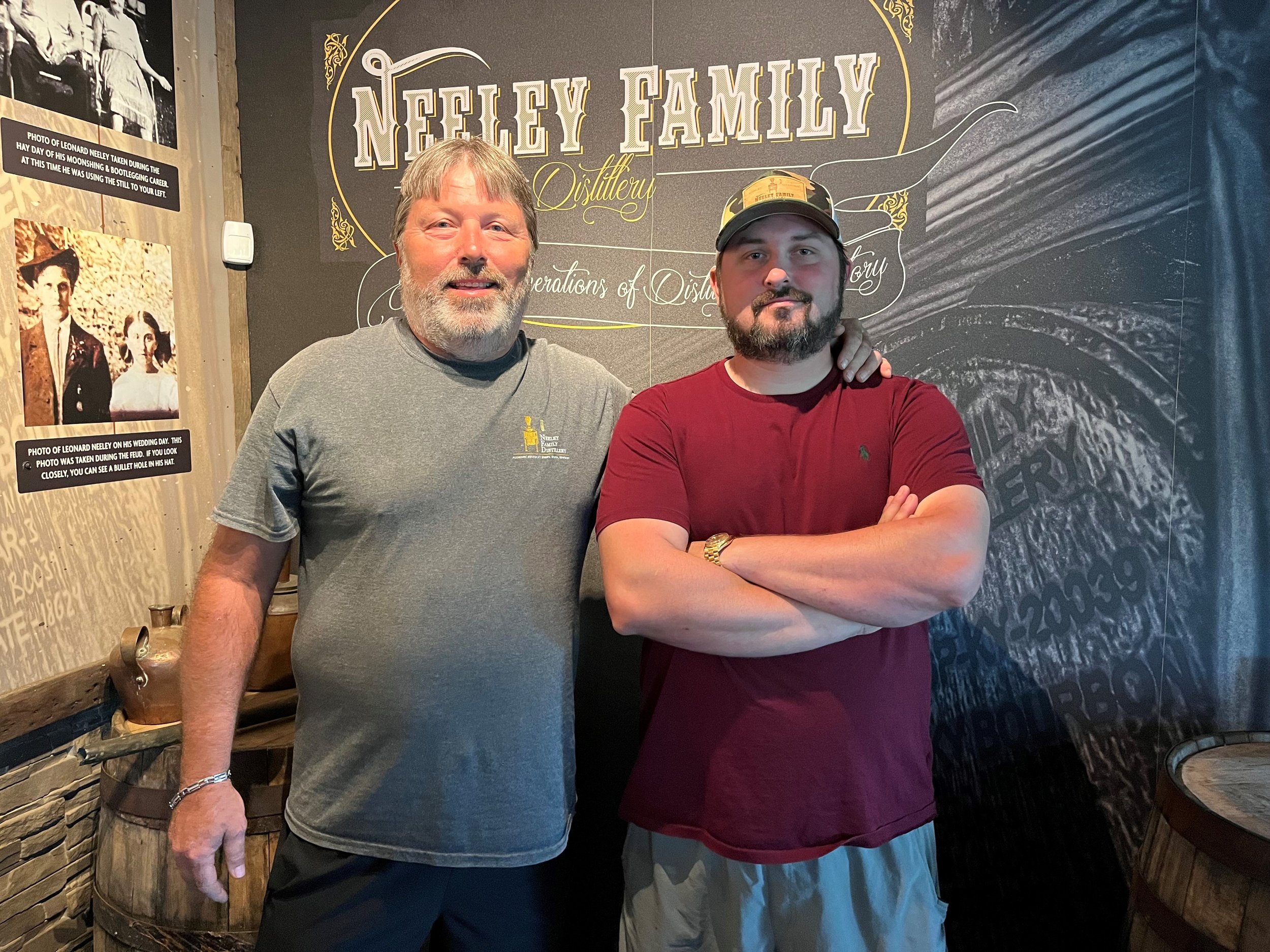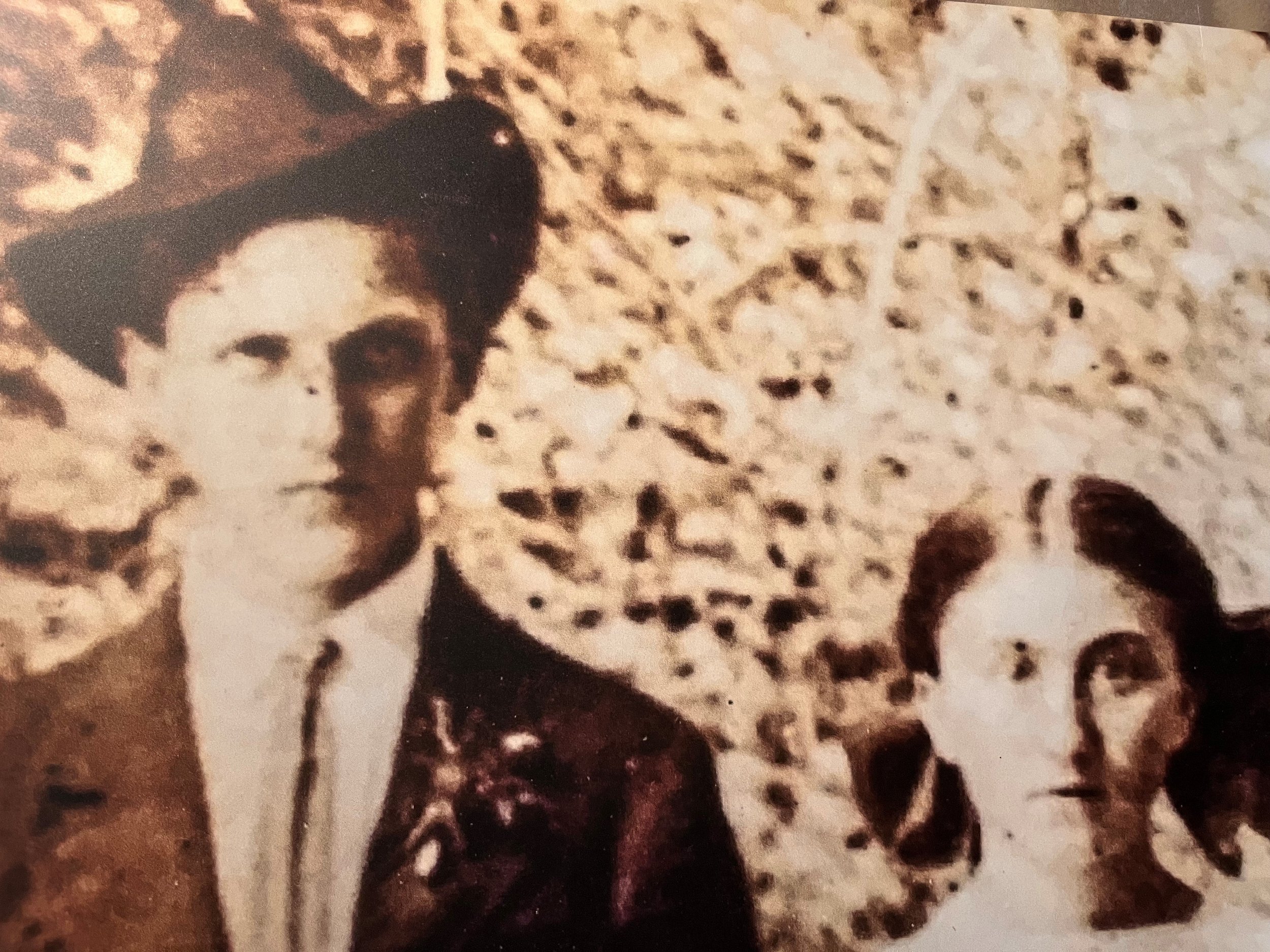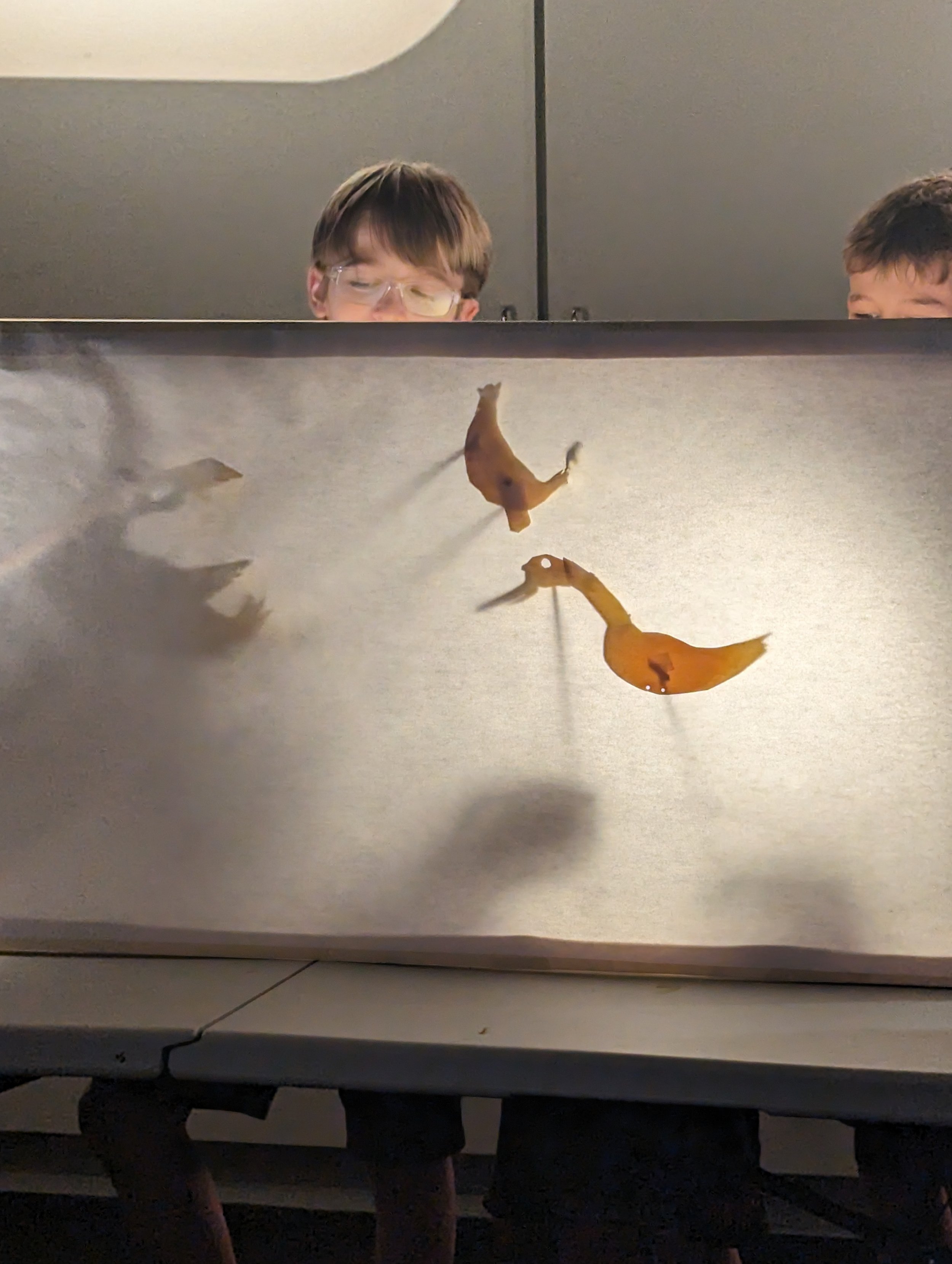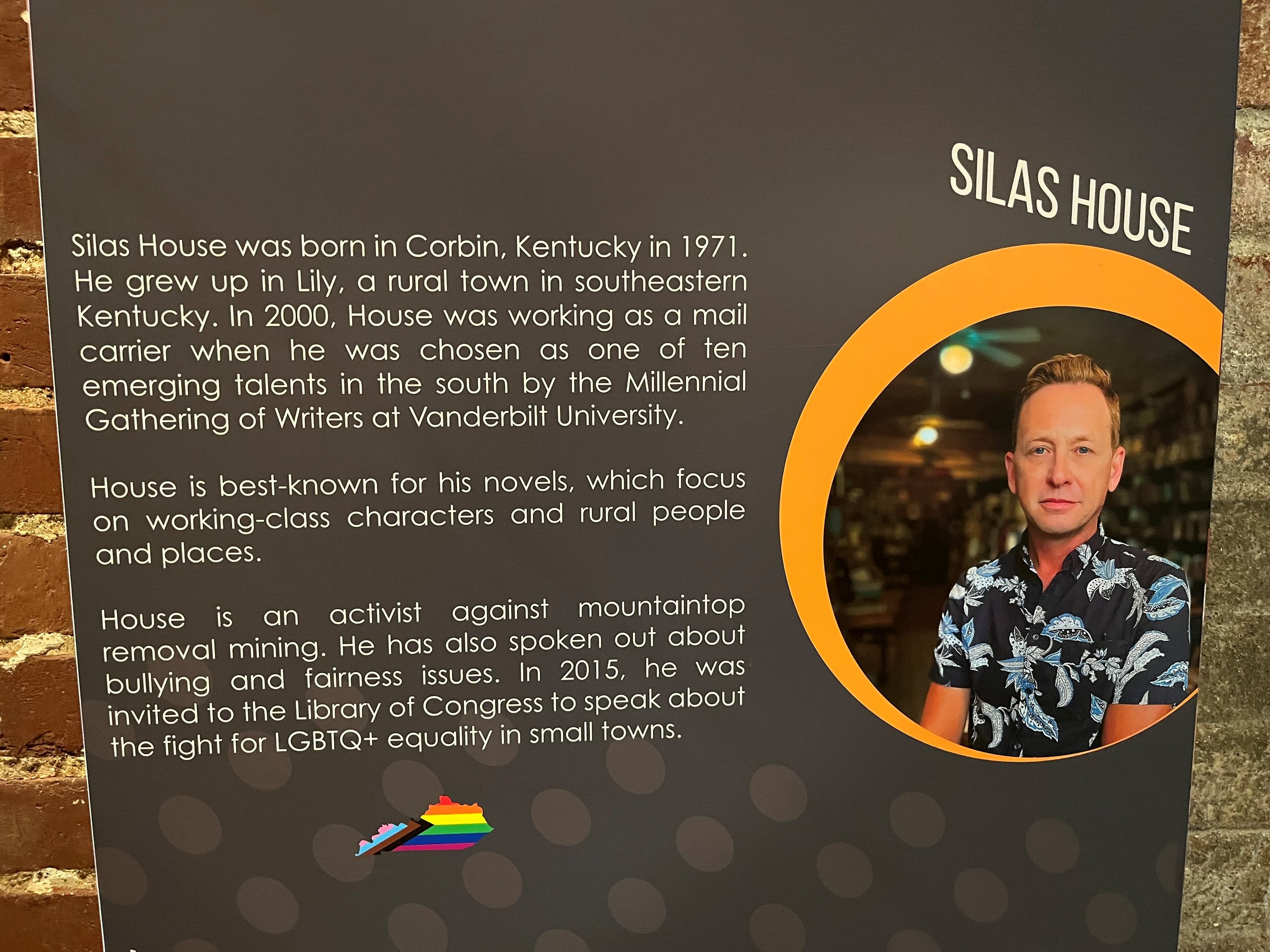Moonshiners Program, Back-to-School Supplies, 1800 & 1900; Black Patch Tobacco Wars, 1904–09, and More
Lead Distiller Royce Neeley with his father Roy Neeley of the Neeley Family Distillery. Photo Credit: Frazier History Museum.
Neeley Family Distillery. Photo Credit: Frazier History Museum.
Good morning,
It’s a quote from Lead Distiller Royce Neeley that certainly got my attention: “We’ve got as much illegal history as the Beam’s do legal and I think people deserve to know about it.”
Now is your chance to learn about it as the Frazier celebrates Bourbon Heritage Month in September in spectacular fashion with 2 different programs. The Neeley family history will be part of our program on September 19th entitled – Moonshine, Hidden Barns and the Law.
Royce Neeley, one of the youngest, if not THE youngest Distillery Owner in the world comes from a long line of moonshiners in Eastern Kentucky. Royce now bottles it legally in Sparta, Kentucky at the Neeley Family Distillery. Yes, it is the original family recipe dating back more than 100 years.
Leonard Pap Neeley (1894-1991) pictured with his wife and bullet hole in his hat.
Royce will be serving up the family moonshine as well as stories about people like his great grandfather Leonard Neeley. Take a look at the picture of Leonard with his wife on his wedding day, that’s a bullet hole in his hat courtesy a longstanding feud with another family over moonshining territory. That’s the tame part.
Join us as we taste three moonshines and two bourbons including Hidden Barn created in partnership with Neeley and Jackie Zykan. The name Hidden Barn also has ties to moonshine.
You’ll also hear from Kentucky author Chris Skates sharing his family story in his new book Moonshine Over Georgia.
Click here to buy tickets and learn more about the program that as Royce Neeley says, takes you back to where it started. And don’t forget about our Yellowstone program on August 30th. Cheers!
Also coming up in Frazier Weekly back to school supplies from days gone by, some of our objects heading to L.A. to honor a Louisville wrestler, and learn more about the Black Patch Tobacco Wars in Kentucky.
Rachel Platt
Vice President of Mission
Frazier History Museum
This Week in the Museum
Barrel .338 Moonshine Flavoring Stick
It’s faster than a speeding bullet to get the most flavor in your bourbon or moonshine! The BARREL .338 is a flavored whiskey barrel stave in the shape of a bullet, made from 100% untreated American white oak. Load the bullet into your select bottle of bourbon or moonshine and let the magic begin. We sell oak, maple and cherry flavors. Click here to purchase.
From the Collections: Back to School Supplies, c. 1800 and 1900
Well, Frazier friends, we’ve reached that time once again. The summer is ending and we’re headed into the new school year. I always loved the new school year. It brought new notebooks, binders, crayons, pencils, and even new ink! I loved laying out the new school supplies and packing them in the bookbag for the first day of school.
But what might those school supplies have looked like in days gone by when paper and ink were too expensive to have in the classroom? How did students learn their letters and math in those classrooms? For today’s Frazier Weekly, we are looking at items from the late frontier age of Kentucky to the early twentieth century. Two different forms of writing and learning: first the hornbook and then the classic slate and slate pencil!
Hornbook made c. 1800 on display in the Frazier’s Commonwealth exhibition. Credit: Frazier History Museum.
Slate and pencil made c. 1900. Credit: Frazier History Museum.
A hornbook was most often made of crude wood and had a sheet attached which had the letters of the alphabet, writing samples, and math sums. They were then covered with a thin transparent piece of horn or mica, making it easy for the students to see through. The student would then be able to write on it and learn their letters or sums. Hornbooks had a handle on them making it easier for a child to manage.
Over time, hornbooks became less useful and the writing slate became popular to use. Slates were made from slate stone and had a wood frame. They often had a cloth tied to the bottom to make erasing easier and were written on with a slate pencil, not chalk. Like the hornbook before it, slates were used because they could be written on over and over by any student in the classroom. The slate you see above is what is known as a “quiet slate,” as it has a leather border sewn around the wood frame. This would make for a quieter writing experience for the student on a wood bench.
Oh, how far education and learning have come—from the one-room schoolhouse to the multi-room and classroom buildings in our city. Even within my own lifetime, technology has changed the experience of learning tremendously. Whereas my concern as a student was making sure I got the cool binders or the bright spiral notebooks, students now think about their Chromebook covers and making sure they have their login information somewhere.
So, however the beginning of school looks to you, we hope that it is fun and joyous, as one can never go wrong with learning.
Tish Boyer
Registrar & Manager of Collections Engagement
Wrapping Up Summer Camps with Our Education Team
Wow, it has been one wild ride of a summer. When we started planning summer camps back in December, I had no clue that I was going to be the one running them. It has definitely been a learning experience for me. While I’m no stranger to Frazier Summer Camp, I didn’t realize all the behind the scenes work that goes into running the camps on a weekly basis. While I was a little nervous to be taking on the role for the summer I knew I had an amazing team behind me from my amazing co-workers to the contract teachers and interns we brought on. If wasn’t for Mick, Brian, Megan, Rachel, Hannah, Tara, Laurel, Leila, and a lot of coffee, I don’t know if I would have survived past the first week.
At times it was a little bit stressful especially as I worked to figure out what my leadership style was. The stress was balanced out by all the fun that was had across the eight weeks. From all the talented guest presenters we had to the visits we made to our friends on Main Street.
Campers printmaking at KMAC. Photo Credit: Frazier History Museum.
Egg drop activity from Frazier rooftop. Photo Credit: Frazier History Museum.
If I had to choose some of my favorite moments from this summer it would have to be the egg drop activity we did during YourStory week as well as watching the SuperPower Dogs at the Science Center. I’m a sucker for anything with dogs, especially super cool working dogs. This is just the tip of the iceberg of all the things we did this summer.
I’m looking forward to taking a break from camps until next time but I’m also very excited to start planning for next time. I have some new ideas for themes and maybe bringing back an old favorite for next summer. The thing I’m most excited about is that I will be doing all that planning with our new employee Zach Bramel. Zach is no stranger to Frazier Camps. He is one of our favorite guest presenters who has been bringing his artistry with the Mary Shelley Electric Co. to Frazier summer camps for quite some time.
Zach Bramel (center) sitting with Frazier campers. Photo Credit: Frazier History Museum.
Friends & Foes Puppet Activity. Photo Credit: Frazier History Museum.
Campers playing hide & seek. Photo Credit: Frazier History Museum.
I’m so excited for what he brings to the table especially his skills as an artist. It’s an exciting time here at the Frazier as Zach is only one of a batch of new hires. I wish everyone a happy school year and hope to see everyone next summer or winter.
Nicole Clay
Interpretive Specialist
Curator’s Corner: Wrestler Jim Mitchell Objects Shipped to LA
There is exciting news from the Collections Department this week! We were recently contacted by Karen Crews Hendon, director of exhibitions and senior curator at LA Plaza de Cultura y Artes in Los Angeles, California. She requested to borrow several objects related to Louisville wrestler Jim Mitchell for an upcoming exhibition titled 18th & Grand: The Olympic Auditorium. The exhibition recounts the eighty-year history (1925–2005) of the Olympic Auditorium, the home for visceral entertainment in Los Angeles and a historic venue that shaped Los Angeles’s past and influenced its future. The exhibition will be on display August 11, 2023–April 7, 2024, so be sure to check it out if you are visiting LA!
Registrar and manager of collections engagement Tish Boyer packs the Jim Mitchell objects to be sent to LA Plaza de Cultura y Artes in Los Angeles, California, 2023. Credit: Frazier History Museum.
But why would a wrestler from Louisville be featured in an exhibition in LA? Jim Mitchell, known as “the Black Panther,” was one of the first African Americans in the modern era of wrestling. After a tour around Europe, the US, and Canada, Mitchell settled in Los Angeles where he became a regular at the Olympic Auditorium. One of his most famous matches against Gorgeous George occurred at the Olympic. After an angry fan tried to attack George, a riot erupted in the auditorium, largely along racial lines. This event sparked a fierce in-ring rivalry, though the wrestlers were friendly outside of it.
Luckily, we didn’t loan all our Jim Mitchell objects to LA Plaza de Cultura y Artes. Look for them to be added to Cool Kentucky this fall.
Amanda Briede
Senior Curator of Exhibitions
Remembering Bloody Monday
Yesterday marked the 168th Anniversary of Bloody Monday, one of the most important dates in Louisville History. In the years leading to 1855, America saw an influx of immigrants, and two of the largest new population groups were Catholics from Ireland and Germany. A rising political party known as the “Know-Nothings” opposed these waves of immigration, fearing the Catholic immigrants would threaten democracy and change America for the worse. The Know-Nothings rose to power through their opposition to immigration - and used violence to do so.
One of the most violent moments took place at 10th and Main, just down the street from where The Frazier stands today. This was near the first Catholic church in the city, and also home to Quinn’s Row Houses. On August 6th, Election Day, the Know Nothings terrorized the Irish community that lived in these buildings. The row houses were set on fire, and many were shot as they tried to escape. The terrorists’ goal was to prevent the Catholic voting block from showing up at the polls, and they were successful through the violence here and in other areas of town. There is still no clear death count from the day, but it is believed to be much higher than the official count of twenty-two.
In the years that followed, Louisville’s German and Irish Catholic population dropped significantly, as many decided to move away. The Know Nothing Party held power in Louisville for several years, but the party as a whole did not survive the Civil War.
History has not remembered the Know Nothings well, largely due their hatred and fear of different people.
In our exhibit The Commonwealth, we have a display with many documents related to Bloody Monday, as well as an informational panel.
Mick Sullivan
Curator of Guest Experience
Shared Sundays: Amanda Briede to Lead Tours August 13
The Frazier has got a very deep bench of knowledgeable staff members! So we’re trying something called Shared Sundays. Each Sunday, a different staff member will lead special tours tailored to their interests. In each Monday’s issue of Frazier Weekly, look for a quick preview of the coming Sunday’s tours.—Simon Meiners, Communications & Research Specialist
This coming Sunday, August 13th, is my turn for Shared Sundays! I will be giving you a curator’s perspective on two of our permanent exhibitions, Cool Kentucky and The Commonwealth: Divided We Fall.
For my tour of Cool Kentucky, I’ll introduce you to some of the bad*ss Kentucky women that we have on display. From Paralympians to politicians, these are some of the women I most admire in the exhibition.
As we walk through The Commonwealth, I’ll point out some of the new objects that were recently added to the exhibition, including objects from the late 1700s. I’ll also talk about the work that we did to make sure that The Commonwealth was as diverse as possible, telling Kentucky’s history in a way that has never been done before.
I hope to see you for a tour or two on Sunday!
Amanda Briede
Senior Curator of Exhibitions
In 1783, the first tax in Kentucky was levied in Lincoln County: ten pounds of tobacco for each tithable. Ever since, tobacco has played a pivotal role in Kentucky—particularly during the Black Patch Tobacco Wars of the 1900s, when American Tobacco pitted farmers against one another, causing masked “Night Riders” to terrorize the countryside. For today’s Frazier Weekly, former Frazier Museum education intern Lindsea Eggen provides an insightful overview of that conflict. To see tobacco-related artifacts from Kentucky history, including tobacco planters and stalk cutters from 1885 to the 1910s, visit the Frazier’s Commonwealth exhibition.—Simon Meiners, Communications & Research Specialist
Costume worn by Night Riders on the night of the murder of Capt. Rankin at Reelfoot Lake, c. 1908. On October 19, 1908, night riders at Reelfoot Lake, Tennessee, kidnapped and murdered Captain Quentin Rankin, an attorney and shareholder in the West Tennessee Land Company. Credit: Brian L. Bossier Collection, Newberry Library.
When it comes to labor history, coal miners in eastern Kentucky tend to take the spotlight with their high profile strikes, their unions, and the infamous Harlan County War. However, Kentucky boasts another labor-intensive, global industry that has certainly had its fair share of skirmishes with big business. In the far parts of southwestern Kentucky and northwestern Tennessee, there are about thirty counties that comprise the “Black Patch,” an area famed for its dark-fired pipe and chewing tobacco. One may think that being the leading worldwide supplier of such a hot commodity would bring prosperity to the small rural towns of the Black Patch, but this could not be further from the truth. Why? Enter: the American Tobacco Company.
James Buchanon Duke, a wealthy North Carolinian, inherited his father’s farming and tobacco manufacturing business and formed the American Tobacco Company (ATC) after absorbing all competing manufacturers in 1890. With near-total control over the pipe, plug, and cigarette markets, Duke became a wealthy man—but he didn’t get there for free. Rather, he did so on the backs of the farmers who supplied his tobacco. In 1900, farmers were able to sell tobacco for roughly 6–8 cents/lb., but by 1904, the price had fallen to only 2–3 cents/lb.—which was 2 cents less than it cost to grow. Planters were taking a loss on their primary cash crop, and James Duke was getting rich.
Farmers in the Black Patch were living in poverty and going hungry; they knew they had to do something. On September 24, 1904, over 5,000 farmers gathered in Guthrie, Kentucky, to make a plan. The night was filled with live music, Bourbon, and barbeque, and the festivities ended with the formation of the Dark Fired Tobacco Planter’s Protection Association (PPA). The PPA was essentially a large union of Black Patch farmers who agreed to boycott the ATC by withholding their tobacco until prices rose. Over 70% of farmers in the Black Patch joined the PPA, but members continued to lose money while watching the other 30%, who they deemed “hillbillies,” get rich selling the newly scarce tobacco to the ATC. They realized that, in order for their plan to work, all of the region’s farmers would need to get involved.
A year later, the PPA met again to discuss how best to deal with the hillbilly issue. David Amoss, dissatisfied with the PPA’s inaction, held his own meeting in early October. Thirty-two farmers gathered in a one-room schoolhouse and, riled up by Amoss’s impassioned speeches, formed the vigilante group the Night Riders. The call to convert hillbillies to the PPA by any means necessary was justified by Amoss’s words ringing in their ears:
Be it further proclaimed to the world that any farmer or persons who aid the Trust in any way by selling to it their tobacco at a higher price is an accomplice of the Trust and is in good morals as guilty as the Trust.
Detailing their agenda in local newspapers, the Night Riders issue a response:
A message the Night Riders wrote and distributed to tobacco farms in parts of Kentucky and West Virginia, c. March 1908. It reads: ““O, Fool, Raise No Tobacco.” NOTICE—Oh, fool: Dare to raise a stalk of tobacco on your land or assist any one else in the raising and ye shall pay the penalty with your home and life. So be ye warned. “NIGHT RIDERS.””
Rallying cries such as these do not make it unbelievable that the Night Riders carried out vicious attacks against hillbillies and the ATC. Although they first destroyed harvests by trampling fields or sewing seed beds with salt, they quickly moved to lighting fields on fire during the night. One of their first headlining raids happened on November 30, 1906, in Princeton, Kentucky. After sending in earlymen warning the townspeople to stay inside their homes, 200 Night Riders rode in and cut the town’s telephone lines and fire station’s water supply. They quickly made their way to JG Orr Tobacco Warehouse, doused the place in kerosene, threw in sticks of dynamite, and lit the warehouse on fire. Attacks only escalated through the next year, and on December 6, 1907, the group set their sights on Hopkinsville, Kentucky—home to two of the ATC’s largest tobacco warehouses and railways. Rather than simply burn the tobacco stockpiles and leave the ash behind, Night Riders stayed and terrorized the town. The newspaper office was destroyed, hillbillies were dragged from their homes and beaten, and shots were fired at those who dared attempt to escape the chaos. As the sun rose, Night Riders waltzed away singing “The Fires Burn Bright on My Old Kentucky Home.” The Daily Kentucky newspaper would immortalize the attack as “A Night of Horror.”
At this point, the PPA had reached its height, with tobacco prices well exceeding 8 cents/lb. and very few remaining hillbillies. Many Night Riders, content with the progress they had made, considered returning to their normal lives. This changed only four days later with the gubernatorial election of Augustus Wilson. Wison was a friend of big business by all accounts. He was a Republican attorney from Louisville, and he had yet to gain the trust of Kentucky’s rural populations. His first acts in office included sending militiamen to Hopkinsville and promising pardons to anyone who killed a Night Rider. This, however, did not stop raids in Russellville, Dycusburg, View, or Eddyville from happening soon after. The wars ended only after political progress satisfied the demands of the PPA. Former PPA member and US Representative A. O. Stanley worked to repeal the tax on leaf tobacco, lifting a huge financial burden from the farmers’ shoulders. In 1911, the Supreme Court ruled that the ATC was a monopoly and therefore in violation of the Sherman Antitrust Act. The court ordered the dissolution of the ATC into four smaller, competing companies. Amoss was also brought to trial, but farmers in the area refused to testify against him, and he was found not guilty.
The Black Patch Tobacco Wars tell a story of rural farmers who, when they had nowhere else to turn, turned to violence. To many, the violence was abominable and unjustifiable, a slap in the face of morality everywhere. To that, I say, if the ruling of David Amoss’s jury trial means anything, it means that when people are faced with impossible circumstances—poverty, hunger, exploitation—sometimes ethics can change. Christian County jurors found that the white collar atrocities committed against the Black Patch by the American Tobacco Company far outweighed any violence on the part of Amoss’s Night Riders. Do you agree?
Lindsea Eggen
Education Intern
Bridging the Divide
The Teaming of Singer Tyler Childers and Writer Silas House
It’s the new music video telling a different kind of love story from Appalachia, gay romance.
In Your Love by singer Tyler Childers tells the story of two coal miners who build a life together in the mountains of Kentucky.
In a recent interview, the Kentucky born Childers says one reason he wanted to tell the story is because his cousin is gay, and once he graduated from college he never came back to Kentucky. Childers wanted to be sure his cousin had a music video on CMT that spoke to him.
Photo Credit: Sam Waxman/Courtesy of the artist.
Wall panel about author Silas House in the Frazier’s Cool Kentucky exhibition. Credit: Frazier History Museum.
Childers collaborated on the video with Kentucky Poet Laureate Silas House who wrote it. House is a member of the LGBTQ community and born in Corbin, Kentucky. He’s represented in the literary portion of our Cool Kentucky Exhibit. House says these are human stories, not political stories.
If you haven’t seen the video yet, click here to view In Your Love.
Rachel Platt
VP of Mission
